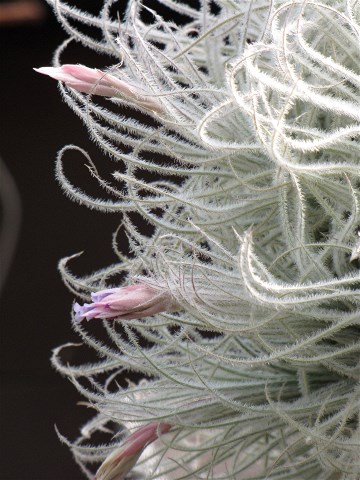Despite the fact that it can sometimes “take years” to find the spot where a bromeliad will thrive in the garden, Johanna Elder is a big fan of these tropical beauties.
Broadly speaking the Vriesea types don’t have spikes, prefer shade and need feeding to reach their full colour potential, while the Neoregelia types have spikes, like full sun and need to be starved of fertiliser to colour up.
Lynley Breeze, president of the Bay of Plenty Bromeliad Group, considers Johanna, who founded the group 18 years ago, as the best grower in the group and a visit to her Cherrywood garden shows why.

Johanna Elder in her garden. Photo: Sandra Simpson
Quesnelia Tim Plowman, a tube-type bromeliad with unusual curled foliage, is being grown in full sun in a stone garden, a bold move with an expensive plant but Johanna says it is responding well.
“Often it’s a case of trying a plant here and there – it will let you know if it doesn’t like something and reward you if it does.” Conversely, she has put a couple of her bright Neoregelia bromeliads into the shade house to see if that will intensify their colour and believes the experiment is working.

Neoregelia Gold Fever. Photo: Sandra Simpson
“It’s heat that brings up the colours in bromeliads not direct sunlight,” Johanna says. A certain amount of stress will intensify colour too, so she adds some slow-release fertiliser when she plants Neoregelias and then leaves them alone.
“Vrieseas however, need as much fertiliser as you can give them.”
While bromeliads of all shapes and sizes and in many colours and patterns form the bulk of Johanna’s plantings her garden doesn’t feel like a nursery – there are also pony-tail palms, ferns, vireya rhododendrons, succulents, cycads and tillandsias (air plants, bromeliad cousins).
“I’m still a gardener,” she says. “It’s just that all the roses and perennials went long ago.”
Johanna first got interested in bromeliads because her brother-in-law was very involved with a bromeliad society. “The first bromeliad I came across I fell in love with,” she recalls.

Aechmea fasciata Kiwi coming into flower. Photo: Sandra Simpson
After moving to Tauranga from Hamilton, husband Bruce recontoured the Cherrywood site – and the way was open to plant it how Johanna wanted.
She also enjoys growing Tillandsias and finds their clumping habit interesting, along with the fact they will grow almost anywhere. “You can throw them into a crook of a tree, hang them from hooks or stake them into a piece of ponga [tree fern]. Some are spiky, some are soft and even when they’re not flowering, they’re interesting to look at.”

Tillandisa tectorum grows in the cloud forests of Peru. The fine hairs on the fronds are believed to protect the high-altitude plant from extreme UV light and to help it collect moisture from fog. Photo: Sandra Simpson
Bruce built a shade house for the less hardy Tillandsias and every spring Johanna takes all the plants off the brushwood wall and sprays it for a moth that can eat the back of the plants and rot them. The indoor ones are sprayed fortnightly with a natural pest control and a weak solution of fertiliser, while the outdoor ones obtain all the nutrients they need from their surroundings.
Johanna grows most of her bromeliads in pots so they can easily be moved to find the growing conditions they prefer and so tender ones can be moved under frost protection in the winter.

Morning sun strikes a selection of Johanna Elder’s Vriesea bromeliads. Photo: Sandra Simpson
Pots are presented in garden “beds” which are filled with stone mulch – the stones release the day’s heat into the night, keeping the temperature up by about 3-4degC, Johanna says. “If any of them do get caught by frost you can hose them down before the sun gets to them and prevent frost burn.
“Not all bromeliads are hardy so it’s important to know which is which.”
Her Tillandsia punctulata grows in a ponga and covers itself in flowers. “A friend said God made Tauranga for Tillandsia punctulata and she’s right. They flower here all year and the flowers can last for 10 months – they won’t even do that in Auckland.”
Johanna and fellow Tauranga group member Gil Keesing staged a display of plants at the Australasian Bromeliad Conference in Auckland in 2013 where one of the guest speakers was Elton Leme, a high court judge in Brazil who hunts new bromeliad species in his spare time – and has found more than anyone else alive.
This article is drawn from two pieces that were originally published in the Bay of Plenty Times and appear here with permission.
Update: In 2017 Johanna downsized her collection and sold her property. Gil Keesing died in 2016.









